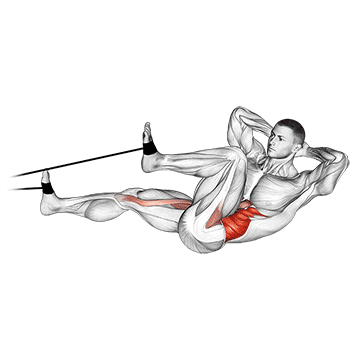The Bicycle Crunch is an advanced abdominal exercise that targets multiple muscle groups in the core. It involves a twisting motion that engages the obliques and rectus abdominis muscles, helping to strengthen and tone the midsection. Adding a resistance band to the exercise can increase the challenge and provide added resistance.
How to perform
To perform the Band Bicycle Crunch:1. Start by lying on your back on a mat or flat surface. Place the resistance band under your lower back, holding one end of the band in each hand.
2. Bend your knees and lift your feet off the floor, keeping your shins parallel to the ground.
3. Bring your hands behind your head, elbows pointing out to the sides, and interlace your fingers.
4. Engage your core muscles and lift your shoulders off the ground, bringing your right elbow towards your left knee while extending your right leg out straight.
5. Twist your torso to bring your left elbow toward your right knee as you switch legs, bringing your left leg in and extending your right leg out.
6. Continue alternating sides in a fluid, bicycle pedaling motion, making sure to keep your core engaged and your lower back pressed into the resistance band.
7. Aim for 15-20 repetitions on each side, or as many as you can do with proper form.
This exercise should be performed slowly and with control to maximize effectiveness and avoid straining the neck or back. Make sure to breathe deeply throughout the movement and maintain proper alignment to protect your spine. Adjust the resistance of the band as needed to challenge yourself while still being able to maintain proper form.
Equipment required
Band
Band equipment consists of elastic bands or tubes that provide resistance during exercises. They are commonly used to strengthen and tone muscles, improve flexibility, and increase range of motion. Bands are versatile and can be used for a variety of exercises targeting different muscle groups, making them suitable for strength training, rehabilitation, and physical therapy. The resistance levels can be adjusted based on the tension of the band, allowing for progressive overload and customization for individual fitness levels.


